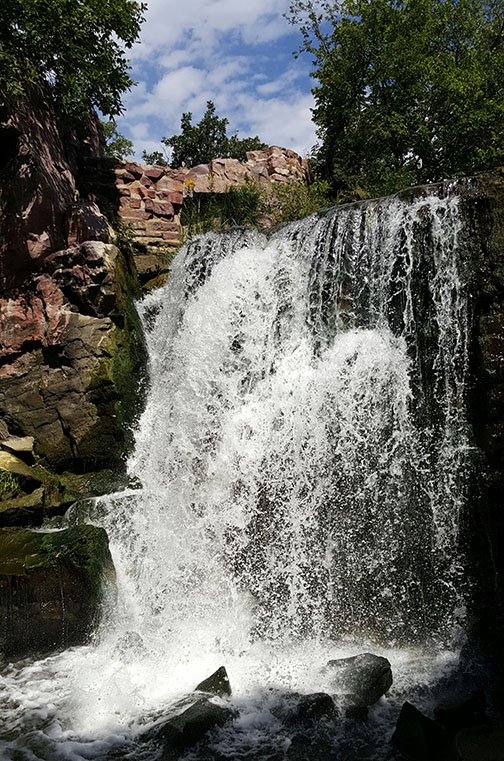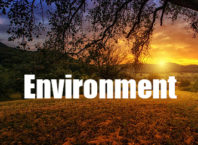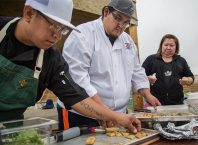 On the high prairies of Southwestern Minnesota one site, and one man, provide a textbook study of the spiritual and political complexities of America’s cultural imposition upon Native American lands.
On the high prairies of Southwestern Minnesota one site, and one man, provide a textbook study of the spiritual and political complexities of America’s cultural imposition upon Native American lands.
For the past 15 years, Glen Livermont, the Oglala Lakota superintendent of Pipestone National Monument, has spent his days walking a precarious tightrope of competing visions. As a career Park Service employee, Livermont says he is obliged to act first in the interests of his employers.
“People will often ask me, ‘As an American Indian, what do you think should happen here?’ While I may have an opinion, and I may have feelings about what should happen, I am still a park service manager, and I need to accommodate that first and foremost.”
The sacred red stone quarries have been visited by indigenous peoples for at least 3000 years. Research indicates the earliest quarrying began around 200 B.C. The Yankton Sioux controlled the pipestone quarries from approximately 1700 until the 1920s, at which time stewardship of the area was transferred to the U.S. government.
Today, no fewer than 23 indigenous nations claim affiliation with the site, each of whom rely upon the red stone for crafting the ceremonial pipes central to their spiritual ways.
Black Elk explained why the red stone is so revered by his Lakota people. “When you pray with this pipe,” he said, “you pray for and with everything.” This quote stands at the top of the Monument’s webpage, one of the myriad ways Livermont has influenced interpretation of the quarries. To manage such a venerated place under the banner of a colonial government would be difficult for a commission of officials, and yet a single Park Service employee is tasked by federal authorities with its care. Livermont seeks commonalities between the Park Service’s mission and the visions Native people maintain for the quarries.
"It is the mandate of the Park Service to preserve and protect natural places for future generations,” he says. “That’s a philosophy that matches so well with many American Indian belief systems. Is this place sacred? I think it is, and as such, it needs the protections that the park service can give it. Fortunately there’s enough of those protections that fall in line with what American Indians believe.”
That doesn’t mean the visions of Native people and the Park Service have never clashed during Livermont’s tenure. The superintendent says sometimes federal employees don’t understand the “special relationship the government has with American Indians.”
Livermont says he runs up against colleagues who have been indoctrinated into the park service so thoroughly they feel they must always strictly follow regulations without regard for that special relationship. “These bureaucrats are not willing to compromise for executive orders that mandate American Indian access to sacred sites; they’re not even sure how to talk with Indians. American Indian employees here must straddle the fence, trying to figure out the right thing to do without jeopardizing our careers. It’s sometimes a major conflict, and I’ve experienced it a number of times.”
The son of an Oglala Lakota mother and white father, Livermont grew up on his family’s ranch in a remote district of the Pine Ridge Reservation, some 20 miles south of Interior, South Dakota. His family did not participate in Lakota spiritual ways. When he was 15 years-old, however, his mother brought him to the town of Pine Ridge, where the first openly celebrated Sun Dance in generations was being held.
“Fools Crow and a few of the other elders were bringing the Sun Dance back. There was a lot of excitement over that,” he says. “Having grown up in an era when there was a prohibition on American Indian spiritual practices, my mother had never seen a Sun Dance before, and so she was eager to go.”
Livermont’s uncle lived in Pine Ridge and told them they should avoid the Sun Dance. He had heard that members of the American Indian Movement were in town from Minneapolis and planned to “disrupt things.” Livermont recalls the electricity in the air as a crowd “waited around the arbor for something to happen.” He also remembers a carnival atmosphere surrounding the dance grounds, complete with circus music, and vendors selling snow cones and cotton candy.
Around noon, a priest arrived wearing beaded vestments. He entered the Sun Dance grounds intending to perform communion. In those days, the ceremony could not proceed without the consent of the Bureau of Indian Affairs and the church. Livermont watched as two men followed the priest, held a quiet conversation, and “guided” the priest off the grounds. Soon BIA police arrived and escorted the men off the reservation.
Young Livermont didn’t know who the AIM men were, or that he had just witnessed the rebirth of the Sun Dance. In the years that followed, dozens of Sun Dances would spring-up across Lakota country.
Nearly three decades later, Livermont gathered with his employees at Pipestone National Monument for a cultural sensitivity presentation by American Indian Movement leader Clyde Bellecourt (in advance of the annual Sun Dance Bellecourt oversees at the site). Bellecourt told the story of how he and Lehman Brightman removed a priest from the Pine Ridge Sun Dance in 1971. It was then that Livermont understood the significance of the events he had witnessed. The two men now work cooperatively to provide accommodations for the dozens of dancers and supporters who converge on the red stone quarries each summer. Livermont credits the events of 1971 with shaping his understanding of who he is as a Lakota person, and with influencing his understanding of his role as superintendent.
One of Livermont’s most important duties is interpretation of the pipestone quarries so that visitors of all backgrounds can grasp their significance. Livermont personally writes much the content included on the Monument’s website, within its visitor’s center, and on its signage.
To help guide this potentially contentious work, Livermont enjoys the advice of an informal council of elders, who, from throughout Indian Country, will knock on his office door and sit down for extended chats. One of these elders, Oglala spiritual leader Wilmer Mesteth, was a particularly welcome site across the superintendent’s desk. Livermont calls the recently deceased Mesteth a mentor and a good friend. The two met while Livermont worked in the South Unit of the South Dakota Badlands.
“Wilmer held a sun dance over in Venture Table. I would stop in and visit with him every year and got to know him that way. When I moved to Pipestone he would visit me. I really respected and liked Wilmer,” Livermont says.
Unlike some of his predecessors, Livermont says he takes his responsibilities under the National Historic Preservation Act quite seriously. Section 106 of the Act requires him to consult with leaders of the 23 tribes historically affiliated with the pipestone quarries whenever changes to the site are under consideration.
“The previous superintendent didn’t believe in consulting with the tribes. But it’s the law, and we have to do it. Because of that spiritual connection they have with the pipestone quarries, it’s also the right thing to do.” Livermont says at first the tribes didn’t take him seriously. They were used to the old way of doing business, where they were told how things were going to change, rather than asked how they should.
Last year, in attempt to educate his colleague on the intricacies of working hand-in-hand with the tribes, Livermont sponsored a training in Omaha. The session drew 25 participants who learned about the rewards and challenges of folding tribal input into Park Service policies. The event, Livermont says, was a tremendous success in transmitting “the American Indian way of thinking.” While he would like to hold annual sessions, the first one may well be the last due to budgetary constraints, which Livermont calls “unacceptable”.
“We in the National Parks Service need to reach out and develop meaningful relationships with the tribes,” he says. “If we don’t, we aren’t meeting our obligations under the law, and we are not doing right by American Indians or the best interest of the sites under our stewardship. We’ve got to start working in a different way.”






